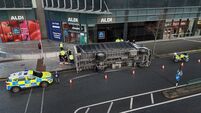New history reveals bookies, bigamists, and Black and Tans

Members of the Royal Irish Constabulary and Black and Tans prepare to abandon a police barracks in East Cork in 1920, during the height of the IRA campaign during the War of Independence.
What odds on this? The man behind one of the world’s best-known bookies opened the chain with compensation he received after being shot while serving as a Black and Tan in Co Cork.
In addition, the founder of the force that terrorised Ireland during the War of Independence was not an Englishman, but a man born in Fermoy, Co Cork.
Meanwhile, another member of the infamous group — the aptly named ‘Mr Moonlight’ — bigamously married a woman in the same North Cork town.
These facts, and more, are contained in a book by retired garda Jim Herlihy, who previously compiled definitive histories of his own police force and its predecessor, the Royal Irish Constabulary.
Years of research has culminated in the definitive history of the Black and Tans, featuring an alphabetical list of short biographies on all 10,940 who served in it.
tells the story of William Thomas Hill, who was shot in the leg in an IRA ambush in Midleton, Co Cork, on April 10, 1921. The Birmingham native was awarded £3,700 compensation and this, with his pension from the force, made him “decide to become a bookmaker”.
Meanwhile, many people would be surprised to learn an Irishman founded the Black and Tans and indeed how many Irish signed up to serve with them.
“Cyril Francis Fleming was born in Fermoy in 1875 and served as a major with the Irish Guards during World War One,” said Mr Herlihy.
“He’d been an inspector in the RIC and was selected to go to London [Scotland Yard] where he recruited Black and Tans. He died in Cornwall in 1957.
“Everybody seems to think the Tans were recruited exclusively in London and they were therefore English. This is not the case. There were 881 Irishmen who joined. The extent of their involvement came as a shock to me. I thought when I started my research there would be just a few.
“The pay was good and they’d be entitled to a pension, so maybe that’s why.”
Mr Herlihy also points to the unusual case of Mr Moonlight, formerly a master saddler. William Stuart Moonlight was born in Fife, Scotland. When he joined in December 1920, he told the recruiting officer he was single. In fact, he’d married the previous year and before he arrived in Ireland, his wife had given birth to a young son.
Moonlight was posted to Lismore, Co Waterford. He bigamously married another woman, née Coleman, who was from that town. She was a widow and they married in nearby Fermoy on March 12, 1921. He was soon found out.
“He was arrested at Lismore barracks and charged with bigamy,” Mr Herlihy said.
Moonlight’s court-martial was held at Victoria Barrack, Cork (now Collins Barracks). He was found guilty and sentenced to nine months hard labour.
The book, published by Four Courts Press, details the three wings of the Black and Tans — the RIC Special Reserve, mainly recruited in Britain; the Temporary Constables, and the Veterans and Drivers Division.
“They were initially given ill-fitting khaki trousers and green tunics and collectively gained the moniker ‘Black and Tans’,” said Mr Herlihy.
“Even though the uniform situation was sorted by December 1920, the title ‘Black and Tans’ would remain long after into history.”
















